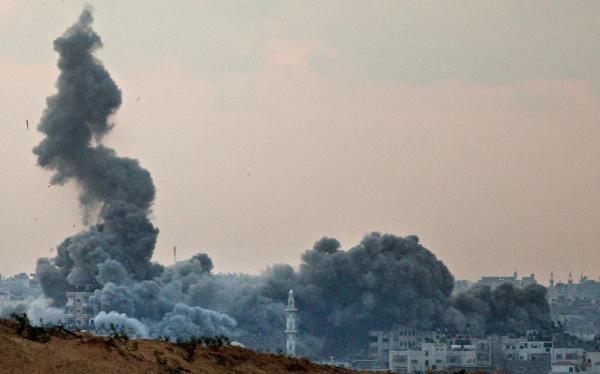Professor Paul Rogers analyses the international and historical context of the current conflict in Gaza, a tragic situation which may finally make clear the fact that prolonged use of extreme force will not achieve security for the region.
This briefing is concerned with the sudden outbreak of fighting in the Gaza Strip which commenced with Israeli air strikes on Saturday 27 December and escalated with a major ground assault starting in early January. While this analysis seeks to look at the wider context of the current conflict it therefore does so in terms of the first two weeks of the war. At the time of writing (9 January 2009) there are several mediation efforts in progress but with the United States unexpectedly abstaining at the last moment in a significant UN Security Council Resolution calling for a ceasefire. The Israeli government insists, meanwhile, that it has the right to continue to protect its security interests. A ceasefire may still be called in the coming days but, whatever the eventual outcome of the conflict, the manner of its development so far already has long-term significance.
Two Weeks On
There is much dispute as to how the tenuous six-month ceasefire between Israel and Hamas broke down. The Israeli government points to the numerous examples of rockets fired into southern Israel, and its particular concern that Hamas has been able to acquire longer-range, if inaccurate, rockets smuggled in from Egypt, in addition to the much larger number of crude rockets produced within Gaza. Hamas, in turn, points to a number of examples of Israeli attacks during the ceasefire. One of these, a commando raid on 4th November 2008 that killed six Hamas paramilitaries, was followed by a near-total blockade of the border. This coincided with the US Presidential Election and attracted very little media coverage but was followed by an escalation in the firing of rockets into Israel.
It is certainly the case that the Israeli Defence Forces (IDF) had undertaken very detailed planning and training for a major air and ground offensive to be directed at Hamas, including a substantial increase in infantry training for urban warfare. Much of this was concentrated at a new facility, the National Urban Training Centre, the mock Arab town of Baladia in the Negev complete with refugee camp. This was built for the IDF by the US Army Corps of Engineers, financed largely by US military aid and has been in operation for the past eighteen months.
The war started with an intense aerial operation involving 88 Israeli strike aircraft attacking 100 pre-planned targets in under four minutes. 400 more targets were hit within the first week of the war, and the Hamas paramilitary organisation undoubtedly experienced substantial disruption and large numbers of casualties, especially in the first attack. In spite of this, 30 or more rockets continued to be fired into southern Israel each day and the second week of the war saw up to 10,000 Israeli ground troops moving into the Gaza strip, supported by strike aircraft, helicopter gunships, artillery and tanks.
By the end of the second week, most of the rural parts of Gaza were under Israeli military occupation, but there had been few efforts to enter into the densely populated urban areas, particularly Gaza City, Khan Younis and the Jabaliya and Beach Camp refugee settlements. There was some evidence that most of the Hamas paramilitaries had successfully re-grouped after the initial air strikes but were being cautious about engaging with Israeli infantry outside of the built-up areas. Furthermore, in spite of the extent of the Israeli military operation and at least 50 further air strikes each day, rockets continued to be launched into Israel.
At this stage, the official Israeli war aim was still to end the rocket attacks, although many analysts contended that the wider aim was to terminate the Hamas regime. Israel’s minimum demand for a ceasefire was thus an end to the rocket attacks and the closure of arms smuggling routes from Egypt. For Hamas it was a complete Israeli military withdrawal and an end to the blockade. Domestic support for the Israeli government remained strong but the very large number of civilian casualties, including over 200 children, and unprecedented criticism from the UN Relief and Works Agency and the International Committee for the Red Cross both added to a mood of antagonism towards Israeli actions in much of Europe and deep anger and resentment across the Middle East.
Israeli Motivations
The context of the conflict is complex. Electoral timescales are significant in at least three respects. The war started with the Bush administration having less than four weeks left, but its support was crucial to Israel. While the incoming Obama administration has many senior officials who are intrinsically positive in their support for Israel, there is still an uncertainty about the new administration’s policies. Within Israel, a closely-fought election is due on 10 February and there is an expectation that a Binyamin Netanyahu-led Likud Party will do well. A “successful” war could instead aid both the Kadima Party led by Foreign Minister Tsipi Livni and the Labour Party under Defence Minister Ehud Barak. Finally, elections are due in Lebanon in August and while Hezbollah emerged greatly strengthened after the Second Lebanon war in 2006, a new conflict with Israel could result in such damage to the Lebanese economy that Hezbollah would lose out at the polls.
Israel’s determination to engage in a war likely to cause high civilian casualties has to be understood in terms of its own perception of insecurity. Although it is a singularly powerful country with formidable conventional forces having access to advanced US equipment and backed up by a substantial nuclear arsenal, it still has an experience of persistent insecurity that is difficult for outside observers to understand. This goes back to the severe losses of the 1973 Yom Kippur/Ramadan War and its marked contrast with the extraordinary military success of the Six Day War of 1967. The failures in Lebanon in 1982-85 are also pertinent as the IDF was forced to retreat in the wake of persistent guerrilla actions by Hezbollah.
Even so, the Lebanon experience of the mid-1980s was a military reversal that had little effect on the domestic security of Israel itself – more important was the experience of the Iraqi Scud missile attacks in 1991, and the more recent experience of suicide bomb attacks, especially in the early part of the present decade. Even more worrying for Israeli strategists was the experience of the 2006 War with Hezbollah, especially the extent to which large parts of northern Israel were at risk from missile attacks, with the IDF unable to defeat Hezbollah, and the repeated launching of smaller rockets from Gaza.
All of these weapons are crude unguided short-range systems with a very limited explosive capability, but that is not the point. Their very unpredictability means that they induce a widespread feeling of fear and impotence in a state that prides itself on its ability to defend itself through its powerful military forces. December 2008’s briefing in the Oxford Research Group’s monthly series of International Security Briefings (Irregular Warfare and Revolts from the Margins)looked at the evolution of irregular warfare from a global perspective, and Israel’s experience with both Hezbollah and Hamas are specific examples with much wider implications.
Moreover, much of the concern of the Israeli security establishment is the manner in which the use of short-range ground-launched missiles relates to Iran. While much of the weaponry may originate in Russia, Ukraine and China, the main channels of supply go through Iran and Syria. The Israelis also have a particular concern with Iran’s substantial programme of developing and deploying much longer-range missiles, along with its presumed nuclear ambitions - the memories of the 1991 Iraqi Scud attacks are still strong.
In summary, Israel is determined to maintain its security primarily through the use of intensive military force and believes that it is aided in this by the support it receives from the United States. There is no immediate prospect of a change in this outlook unless there are unexpectedly radical alterations in US Middle East policy under Barack Obama.
Israel and Egypt
Israel is adamantly opposed to Hamas and sees it purely as a terrorist organisation linked to its own “axis of evil” comprising Hamas, Hezbollah, Iran and, to an extent, Syria. It cannot accept that Hamas has a legitimacy by having sufficient popular support to win an election, nor does it accept that Hamas has been widely seen in Gaza as a far more effective representation of Palestinian aspirations than Fatah, especially with the latter’s endemic problems of corruption. Israel finds the Gaza situation deeply problematic and it must be remembered that its withdrawal from the territory in 2005 was not part of a peace process but because a continued occupation in support of a very small group of settlers was economically and militarily unviable.
It is also not widely recognised that the Egyptian government is opposed to Hamas – indeed its treatment of Palestinians crossing the border from Gaza in recent months has frequently been non-cooperative and even aggressive. The Mubarak regime fears Hamas because of its potential effect on its own massive underclass, for whom Hamas can be seen as a figurehead organisation opposing exploitation. This is a powerful narrative and does much to explain the Egyptian elite’s willingness to work closely with Israel. Egypt’s concern about Hamas is shared, to an extent, by other elite regimes across the region, some of whom are also concerned with Iranian influence, even if Hamas draws its support almost entirely from Sunni communities.
It is also frequently forgotten that the great majority of the people in Gaza are refugees or the descendents of refugees, primarily from the Israeli War of Independence of 1948, whereas most Palestinians in the West Bank are not. The refugee issue is far more important in Gaza. There is also one crucial element that provides support for Hamas, in that the uniform view in Gaza is that Israel as a state is not in any way interested in seeing a viable Palestinian state being created. This may not be the case, since many Israelis do support such a settlement, but recent Israeli actions on the West Bank provide much support for the Hamas view.
Thus, if Israel says that Hamas must give up its opposition to the existence of the State of Israel before any kind of negotiation can ensue, then Hamas politicians point to the failure of the concessions that Fatah has made on this issue to have kind of positive impact. It is not difficult for them to make this case since the recent experience in the West Bank is of many thousands of additional settlers, the maintenance of extraordinarily strict security procedures that hugely limit economic activity, and over 10,000 Palestinians detained without trial.
Put bluntly, the deeply entrenched Israeli view is that security can only come through military strength and the willingness to use very high levels of force, whatever the international reaction, as long as it continues to have the backing of the United States. Hamas believes that there is no alternative to armed opposition and that Israel will not respond to weak opponents. In the first two weeks of the war it has gained much status across the Middle East and beyond. Moreover, this is a conflict that is widely seen in the region as something close to a joint Israeli/American operation against an impoverished and overcrowded community, with this having important implications for longer-term radicalisation.
Conclusion
It is highly unlikely that the Israeli war against Hamas can completely destroy the movement. However much it may be possible to limit the paramilitary capabilities of the organisation, the civil casualties and levels of destruction will further embed opposition to Israel within Gaza, and more widely among Palestinians in the West Bank. It will also result in much more widespread anti-Israeli and anti-American radicalisation with unpredictable consequences.
There have been many major conflicts involving the establishment and consolidation of the State of Israel, including 1946-8, 1956, 1967, 1973, 1982-5, two intifadas, and Lebanon in 2006, but the Gaza War of 2008-09 may end up being the one conflict that finally makes it clear that sustainable security for Israel cannot be achieved by the intense use of military force. At the time of writing that is difficult to argue, certainly within Israel, and it is unlikely to be recognised there without the intervention of outside states. One of the enduring tragedies of the current conflict is that it is happening when there are significant proposals being developed, especially the Arab Peace Initiative, which do provide a realistic way forward. (see ORG’s November 2008 briefing paper, The Arab Peace Initiative: Why Now?).
Paul Rogers is Professor of Peace Studies at the University of Bradford and Global Security Consultant to Oxford Research Group (ORG). His international security monthly briefings are available from the ORG website at www.oxfordresearchgroup.org.uk.
This article is adapted from the January 2009 Monthly Security Briefing for the Oxford Research Group.






